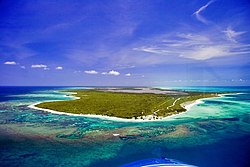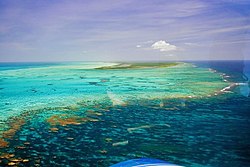Anegada
| Anegada | |

| |
|---|---|
| Main village: | The Settlement |
| Location | |
| Area: | 15 square miles |
| Highest point: | 28 feet |
| Data | |
| Population: | 200 (approx.) |
Anegada is the northernmost of the British Virgin Islands, and the second-largest. It lies approximately 15 miles north of Virgin Gorda.
Anegada is the only inhabited British Virgin Island formed from coral and limestone, rather than being of volcanic origin. While the other islands are mountainous, Anegada is flat and low. Its highest point is only about 28 feet above sea level, earning it the name which translates as “the drowned land.”
At about 15 square miles, Anegada is the second largest of the British Virgin Islands, but it is also the most sparsely populated of the main islands with a population of roughly 200. Most of the population on Anegada live in the main town, The Settlement.
Tourism
The primary business on Anegada is tourism. On a typical day during the tourist season, the island will have an additional 200 or so visitors. Commercial fishing is also a substantial business on Anegada, with local fishermen providing the majority of the fresh fish and lobster catch for the rest of the British Virgin Islands.
Its miles of south shore flats has a large population of bonefish, making Anegada a popular destination for fly fishing.
Access to the island is via the small Auguste George Airport (NGD), thrice-weekly ferries, and private boat. Flights are also available directly to Anegada from other Caribbean islands.
Horseshoe Reef

Anegada is known for miles of white sand beaches and the 18 mile-long Horseshoe Reef, the largest barrier coral reef in the Caribbean Sea, and the fourth largest on earth. The reef makes navigation to Anegada difficult. While charter boats freely sail among most of the other Virgin Islands, charter companies often forbid clients to sail to Anegada to avoid running aground on the reef.
The reef has claimed hundreds of shipwrecks, including HMS Astraea in 1808,[1] the Donna Paula (1819), the MS Rocus (1929)[2] As such, it was once an important scuba diving destination. In an effort to protect the reef, the BVI government has made anchoring on Horseshoe Reef illegal.
Fauna
Anegada is also known for miles of white sand beaches, the large salt ponds which cover much of the west end of the island, and unique fauna. In the 1830s thousands of Caribbean Flamingos lived in these ponds, but they were hunted for food and feathers throughout the 19th and early 20th centuries and disappeared by 1950. They are now being re-established into the ponds. The birds are another tourist draw, but officials are trying to keep the number of visitors to the flamingo areas at a level that allows the birds to flourish.
Other rare or endangered animals include the Anegada rock iguana (Cyclura pinguis) and several species of turtles. Conch, Caribbean lobster (Metanephrops binghami), and many fishes can be found near Anegada, particularly in the deep waters off the North Drop to the north of the island.
The reef adjacent to the Settlement used to be one of the more fertile conch grounds in the Caribbean, but overfishing has wiped out the conch population at the site. Visitors to the settlement are greeted by the sight of mountains of empty conch shells on the shore when they arrive.
There are also populations of feral cattle, donkeys, goats and sheep which live in all areas of the island.
Western Salt Ponds of Anegada were designated a Ramsar Site on 11 May 1999.
Hurricanes
On the 30 August 2010 the eye of Hurricane Earl passed quite close by just north of Anegada. The close passage led to significant damage from the hurricane on the island with major flooding from the storm surge.
Christmas Tree

The world famous Anegada Christmas tree was erected 15 December 2007 at the roundabout. It is the highest Christmas Tree in the British Virgin Islands standing 35 feet high and having almost 15,000 lights upon it. It was donated by a Canadian friend of the island and is erected and maintained by the Anegada Cultural Committee. The committee hopes to build the tree lighting ceremony into a regular event to bring together the people of Anegada. The official tree lighting ceremony takes place on the first Saturday evening of December each year.
Outside links
References
- ↑ Blytmann, Tage W.. "The Saga of the Anegada Island Shipwrecks". http://www.blytmann.com/anegada.htm. Retrieved March 25, 2006.
- ↑ Better known as the "Bone Wreck"
| The British Virgin Islands |
|---|
|
Anegada • Beef • Bellamy Cay • Buck • Carvel Rock • Cockroach • Cooper • Dead Chest • Diamond Cay • Dog Islands • East Seal Dog • Eustatia • Fallen Jerusalem • Frenchman's Cay • George Dog • Ginger • Great Camanoe • Great Dog • Great Thatch • Great Tobago • Green Cay • Guana • The Indians • Jost Van Dyke • Little Camanoe • Little Jost Van Dyke • Little Thatch • Little Tobago • Marina Cay • Mosquito • Nanny Cay • Necker • Norman • Old Jerusalem • Pelican • Peter • Prickly Pear • Round Rock • Saba Rock • Salt • Sandy Cay • Sandy Spit • Scrub • Tortola • Virgin Gorda • West Dog |